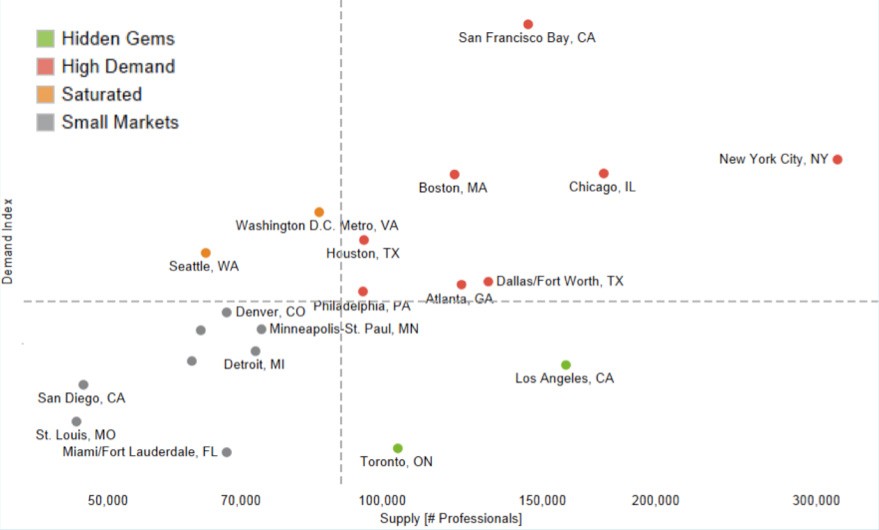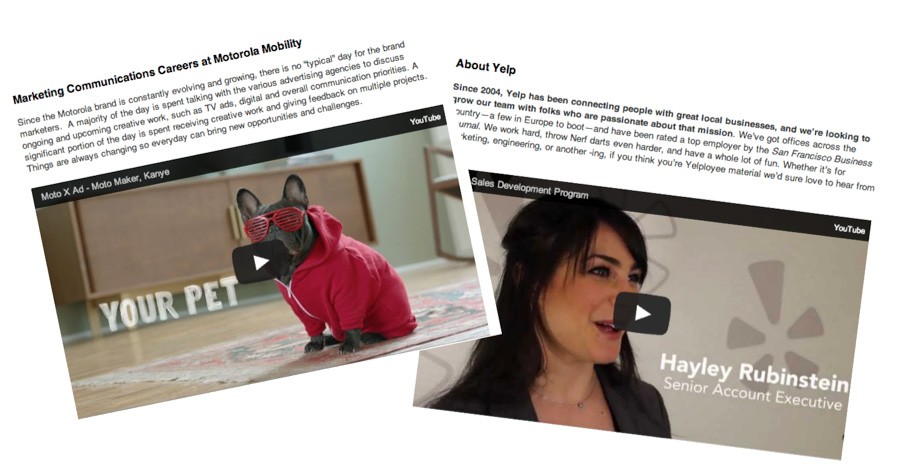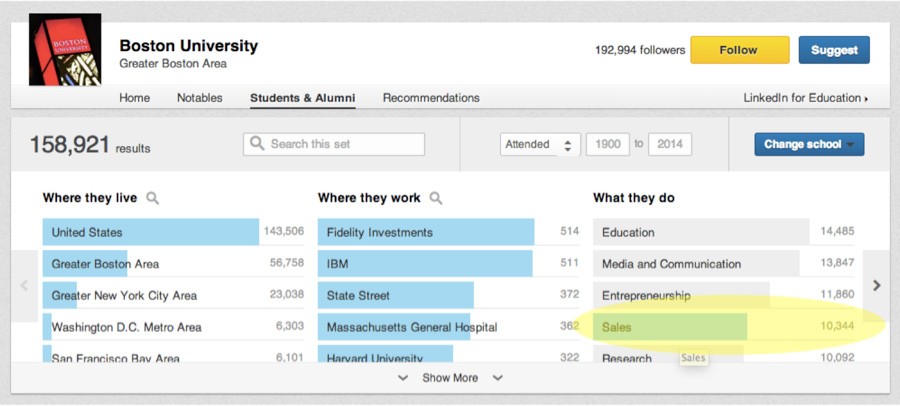3 Specific Steps for Finding Top Salespeople
If you ever feel like sales professionals are impossible to recruit, don’t take it personally. Turns out—sales is quickly becoming one of the most competitive professions to hire for today.
No one knows this pain better than Bay Area companies, where the demand for sales talent is higher than anywhere else in the country. (Note to self: If I ever go into sales, the Bay Area is the place to be.)
So what’s a recruiter seeking top sales talent to do?
Step One: Understand the Sales Market Supply and Demand in the U.S.
Not all geographies are created equal, particularly when it comes to recruiting sales talent. We looked at the locations and activities of our 4 million U.S. sales professionals on LinkedIn, and mapped out regions by supply and demand.
Here’s what we learned:
The farther to the right you look, there is exponential increase in the supply of sales professionals in those regions.[1] And the farther upyou look, the higher the demand for sales talent in those regions.[2]
This means that cities in the lower right-hand quadrant (like Los Angeles and Toronto) are “hidden gem” areas where sales talent is in relatively high supply, and low demand.
In contrast, regions in the upper right-hard quadrant (like Chicago, the San Francisco bay, and New York City) are competitive markets with relatively high supply and high demand.
Understanding that the U.S. market for sales professionals differs drastically depending on where you are is the first step towards overcoming the associated challenges.
Step Two: Optimize Your Hiring Strategy For Your Location
A recruiter looking for sales talent in San Diego and a recruiter looking in Chicago are both going to run into challenges—but their solutions are very different because of where they’re located.
For instance, a recruiter in a low supply and low demand region like San Diego might have trouble finding qualified candidates (or affording the talent they want), while a recruiter in a high demand market like Chicago can easily find sales professionals, but might experience a low InMail response rate or lose candidates in the pipeline due to competition.
If you’re in a low supply region, consider:
- Hiring for potential not just proven experience
You can teach selling strategies, but personality, passion, and a willingness to learn are innate. Look beyond job history and find talent with the potential to make exceptional salespeople for your organization. Often times, these “adaptable hires” bring a unique perspective to the company and make some of the most game-changing employees.
- Tapping your network on LinkedIn
A recruiter’s best resource is her network, and knowing how to get the word out about a new opportunity will help you find those otherwise hard-to-locate professionals. Tapping your network is as simple as sharing a status update on LinkedIn or sending a personalized InMail to people who may know someone, and encouraging all your employees to do the same. Just remember—you can’t expect someone to pass you a lead if you don’t do the same for them. Build your relationships over time, and reach out to your network when the time is right.
If you’re in a high demand region, here are two things you can do:
- Strengthen your company talent brand
Companies in competitive markets must proactively build their talent brand, or candidates won’t give your position a second thought. Our research has shown that almost half of candidates regularly research companies (via simple online searches on Google and LinkedIn) even when they’re not actively looking for a new opportunity, so it’s always a good time to define and promote what makes your company one-in-a-million.
- Grow your employee referral program
Employee referral programs are a great way to motivate your team to source talent on your behalf, exponentially expanding your reach. The networks of your team members are more likely to draw candidates with a closer cultural fit to your company. Most small businesses (defined as fewer than 200 employees) typically offer around $2,000 in bonus per referral, but if your organization is not in a play to offer monetary incentives, consider other rewards like public recognition, a team party, extra vacation time, or anything else your employees would value.
Knowing what unique challenges come with your location will help you craft a proactive recruiting strategy to solve them.
Step 3: Explore (free) tools like the LinkedIn Alumni Tool
If you’re interested in finding graduates from a given university (like the local college in your area, your preferred colleges to recruit from, or even your own alma mater), look no further than the LinkedIn Alumni Tool. This free tool allows you to discover LinkedIn members who graduated from a given university, and then filter graduates by where they live now, where they work, and even what they do (i.e. sales). This is a fantastic way to size the opportunity for recruiting at given universities, and to zero in on a qualified pool of sales applicants.
When you click into sales graduates (highlighted above in yellow), you’re taken to a page with all qualifying LinkedIn members in your 1st, 2nd, and 3rd degree connections. You can drill through the results to filter by graduation date, and even the number of shared connections you have. Send an InMail on the spot, and let the networking begin!
Want more tips and tricks? Watch our recorded webcast on finding and hiring top sales talent.
[1] Supply is defined by the number of LinkedIn members in a given region who are in the sales profession.
[2] Demand is defined by the frequency that sales professionals are contacted by recruiters via inMail.
Topics: Recruiting tips
Related articles






